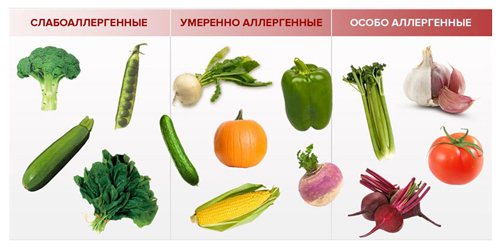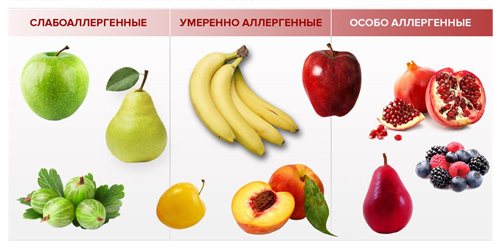11.11.201617.09.2020 Nadezhda Plotnikova
Complementary feeding is food prescribed to infants when they reach a certain age and physiological norms. Such food is intended to complement mother's milk or artificial formula, whose composition and calorie content can no longer satisfy the baby's increased needs.
Since in the first 12 months the foundations for the child’s future lifestyle and health are laid, every parent needs to understand at what age it is best to start feeding their babies, how to properly introduce complementary foods and what food should be given in each month.
General information
The question of how to introduce the first complementary foods to a child at a certain period is very important for every mother.
There is very different information about how the baby’s first complementary foods are introduced. At the same time, information on the Internet is fundamentally different from what people of the older generation talk about. But no matter how many recommendations a young mother receives, it is important that the baby’s first complementary foods are introduced as correctly as possible. That is why you need to familiarize yourself with those recommendations that will allow you to get answers to the most important questions. For example, at what age can you give water to a baby, at what months can you give cottage cheese, and the like.
Every mother needs to familiarize herself with this information in detail so that she can provide her baby with complementary feeding that will be introduced correctly. This, in turn, will ensure that both the breastfed baby and the bottle-fed baby will have a properly functioning digestive system.
First complementary foods during breastfeeding, general rules
Young mothers always have a lot of questions about how to properly introduce supplementary feeding, whether it is necessary to give water, etc. First of all, it is important to take into account that with full breastfeeding , that is, if the mother maintains the feeding schedule, the baby is actively growing, supplementary feeding The child does not need it before six months.
Sometimes mothers, believing that the baby is not receiving enough breast milk, begin supplementing with formula . However, most pediatricians, including Komarovsky, believe that there is no need to supplement well-developing babies. When to give additional formula and whether it should be done, it is better to ask your pediatrician.
A table or chart for introducing complementary foods during breastfeeding will help every mother understand how to practice introducing a new product. This table clearly outlines when to introduce complementary foods during breastfeeding by month, and exactly what foods should be given at certain times.
However, the beginning of the process of introducing complementary foods raises many questions about how and when to start giving a child a certain product. For example, is cauliflower or corn porridge , is it possible to give prunes to a six-month-old baby, when to give water to a newborn, etc.
Ideally, every mother should not only study the literature, but also regularly consult with a pediatrician. It is he who will clearly answer questions about whether pumpkin is ok for breastfeeding, whether broccoli is ok, etc., and will also adjust the complementary feeding regimen that you intend to practice.
When to start complementary feeding?
The question of how many months can a child be fed worries every new parent. But there is still no definite answer, there are only recommendations.
It should be realized that age alone cannot be a “symptom” of children’s readiness; several important characteristics of child development must be taken into account, for example:
- type of feeding of the child (breast milk or formula);
- body weight, which should be twice the weight of the baby at birth (for children born prematurely - about 2.5 times);
- the child’s lack of a repulsive tongue reflex in response to the offer of a drink or food in a spoon;
- the baby’s ability to sit (including in a “feeding” chair), leaning his body towards the spoon or leaning back (this demonstrates the desire to eat or refusal to eat);
- signs of hunger, when the child very often asks for a breast or a bottle and still does not get enough;
- children's interest in adult food and desire to try it.
A complex of all signs of readiness appears in different children at their age. As a rule, the introduction of complementary foods occurs between 5 and 8 months (everything is individual).
With natural feeding, when the child’s needs for essential nutrients are fully satisfied by milk, there is no need to rush into introducing complementary feeding. Children who are bottle-fed are given complementary foods at 5 months.
When to introduce complementary foods to an infant?
There are a lot of recommendations on when to start feeding your baby. And if you believe the experience of grandmothers, complementary feeding should be started as early as possible.
However, any questions that concern a young mother about how many months a baby can be fed and what exactly she should start feeding should first be asked to the pediatrician.
Indeed, in recent years, the approach to what time to start feeding a baby, and where to start best, has changed significantly. And if the majority of modern grandmothers really are of the opinion that, for example, porridge for a three-month-old baby or cottage cheese for a 4-month-old child is normal, then doctors believe otherwise.
All scientific research conducted by modern scientists and doctors confirms that the answer to the question at what age can a baby be fed is as follows: if exclusive breastfeeding is practiced, then feeding the baby should begin no earlier than 6 months . The recommendations for how many months can a child who grows up on artificial feeding : such children are introduced to complementary foods a month earlier, but it is also quite acceptable to start getting acquainted with “adult” food from 6 months.
It is very important to take into account all the nuances: what, when, how much to give to the baby. If the baby is approaching six months of age, you should ask the doctor all the pressing questions: when to give the yolk, when to introduce potatoes. It is equally important to know when to introduce meat into your baby’s complementary foods, and what meat to start with. In order to correctly carry out the process of introducing complementary foods and learn everything about its features, parents are also recommended to study special modern literature.
Why shouldn't complementary foods be introduced earlier?
Parents who are trying to take into account all the important rules for introducing complementary feeding should understand that for infants under 6 months of age, any food other than breast milk or formula is not only not beneficial, but also harmful.
Complementary feeding is not introduced to an infant earlier, since a baby under six months does not have the necessary enzymes to digest new types of food. Therefore, if the rules are violated and the baby receives certain food earlier (even if it is pumpkin or other “light” foods), it will not be absorbed and will not benefit the body. And if food is not digested, then a serious load on the body , and even small quantities of any food will create a load. That is why the procedure for introducing complementary foods according to Komarovsky, as well as according to the recommendations of other specialists, provides for a certain sequence of introducing vegetables and other products.
When and how to start correctly depends on what the baby eats. The first complementary foods during artificial feeding are introduced a little earlier due to the fact that the enzyme systems in such children mature a little earlier. There is a special table for introducing complementary foods during artificial feeding, which can greatly facilitate the introduction of new foods. However, there are certain general recommendations not only about when to start, but also how to introduce it correctly: the introduction scheme provides that any new food is given to the child in an amount of 5 g daily. Gradually, the volume of food increases, usually every day, over the course of a week, and is eventually brought up to 100 or 150 g.
However, it is still recommended to consult with a doctor at what age exactly to introduce new food, and when to introduce this or that product during artificial feeding.
It is advisable to introduce complementary foods during mixed feeding in the same way as during artificial feeding - from about five months . Correct administration during mixed feeding involves initially giving the child one type of vegetable and increasing the number of grams of supplementary food every day for 1-2 weeks.
There is a special complementary feeding table for infants who are breastfed , bottle-fed or mixed-fed . It suggests a special scheme for introducing complementary foods, there is information on where to start, etc. Similar schemes for how supplementary feeding occurs are offered by Dr. Komarovsky and other specialists.
Table of supplementary feeding for breastfed and bottle-fed children
| Age (months) | Products |
| 6 | Broccoli, cauliflower, carrots, zucchini, pumpkin. |
| 7 | Porridge: corn, rice, buckwheat. Porridges should be dairy-free. |
| 8 | Meat: rabbit, turkey, chicken, veal, lamb. Potatoes, yolk. |
| 9 | Fermented milk products: cottage cheese, kefir. |
| 10 | Fruits: prunes, pear, apple. |
Modern table for the introduction of complementary feeding according to WHO (by baby’s age)
| Baby's age | 6 | 7 | 8 | 9 | 10 | 11 | 12 |
| Fruit puree | < 30 ml | < 50 ml | < 60 ml | < 70 ml | < 90 ml | < 100 ml | 100 ml |
| Vegetable puree | < 30 g | < 50 g | < 60 g | < 70 g | < 90 g | < 100 g | |
| Porridge | < 100 g | < 150 g | 150 g | < 180 g | < 200 g | 200 g | |
| Fruit juices | < 30 g | < 50 g | < 60 g | < 70 g | < 90 g | < 100 g | |
| Vegetable oil | < 3 g | 3 g | 3 g | 5 g | 5 g | 6 g | |
| Cottage cheese | < 30 g | < 40 g | < 50 g | 50 g | < 80 g | ||
| Wheat bread | < 5 g | 5 g | 5 g | < 10 g | 10 g | ||
| Cookies, crackers | < 5 g | 5 g | 5 g | < 10 g | 10 g | ||
| Butter | up to 4 g | 4 g | 4 g | 5 g | 5 g | ||
| Egg yolk | 1/4 | 1/2 | 1/2 | 1/2 | |||
| Meat puree | up to 30 g | 50 g | up to 70 g | up to 80 g | |||
| Kefir | 100 ml | up to 150 ml | up to 200 ml | ||||
| Fish puree | up to 30 g | up to 60 g | up to 80 g |
First feeding and child health - nutritional features
There are cases when complementary foods are introduced not according to a general, but according to a special scheme. This is important for mothers whose babies have health problems to know. Let us note several common situations that young parents and their children face.

Digestive problems
If a child often has problems with the gastrointestinal tract, then porridge would be a suitable complementary food for him. If you are prone to constipation, the first complementary food should be plant foods (vegetable puree). Infants older than 7.5 months may benefit from infant milk products containing pro- and prebiotics. They restore intestinal function in the best possible way and create ideal conditions for the development of beneficial intestinal bacteria.
Underweight
Low birth weight infants need to supplement their diet with new foods with caution. Feeding babies who are lagging behind in weight should first of all be provided by breast milk/formula. The first complementary food for an underweight baby should be porridge - choose a product additionally fortified with calcium, iron and zinc.
Tendency to allergies
Babies with allergies should be introduced to complementary foods a little later than others - at about 5-6 months. Dairy-free porridge is a great start to complementary feeding and should be gluten-free. It is also worth paying attention to hypoallergenic industrial products; they have appropriate inscriptions on the labels.
Parents of healthy children should also be attentive and not rush to master the entire range of complementary feeding products with their infants. Introduce your baby to 1-2 types of new foods and allow the baby’s body to get used to them for at least a week. Boiled food is easier to tolerate, even fruits are recommended to be given boiled or baked (for example, a baked pear or apple is well digested).
Advice! Offer the next product only in the morning or before lunch: this way you can assess the body’s response throughout the day and draw the right conclusion regarding a specific ingredient.
How to introduce complementary foods by month
Each modern monthly complementary feeding table provides that the child receives additional feeding from 6 months . However, many families still practice earlier introduction of complementary foods, believing that the nutritional norm for a newborn involves more abundant nutrition than exclusive breastfeeding.
Some sources, which describe the introduction of complementary foods by month, note that complementary foods should be included in the menu of a child under one year of age, focusing on the following indicators:
- compared to the original birth weight, the baby’s weight has become twice as large;
- the child sits independently;
- The baby's feeding schedule is changing: the baby asks for the breast more and more often;
- The development of a child under 1 year of age is very active: he is already interested in what is on adults’ plates;
- The baby does not push pieces of food out of his mouth.
Nutritional standards also take into account that the introduction of complementary foods should begin at a time when the baby will not receive vaccinations .

The degree of allergenicity of vegetables
When young mothers just begin to study the nutrition of children under one year by month, they often believe that when breastfeeding, they should start supplementing their baby with fruit juice. But both research by specialists and the complementary feeding table for children under one year old indicate something else: juice can cause not only digestive problems, but also allergies , as well as excess weight due to the high sugar content in fruit juices . Therefore, the monthly menu should be written differently.

The degree of allergenicity of fruits
Also, the mother should take into account the food norm for the newborn. Complementary feeding needs to start with very small portions, and sometimes it takes up to a month until the baby is completely accustomed to a certain type of food.
If a child feels unwell and becomes restless, before introducing complementary foods, it is worth doing blood tests, determining the norm of bilirubin in newborns, etc.
Signs of readiness to start complementary feeding
Of course, every baby is different. Therefore, the processes of growth, acquisition of motor skills and functional maturation of the main organs are purely individual. The pediatrician who has been monitoring the child since birth will, together with the parents, determine the best timing for starting complementary feeding. However, there are universal signs of readiness that most experts focus on:
- the baby holds his head confidently, sits independently or with support;
- the baby's weight has doubled since birth;
- The baby remains hungry even after feeding.
All of these signs indicate that it is time to consider supplementing with nutrients. As a rule, simultaneously with these signs, food eating skills are formed in the form of recognizing a spoon and opening the mouth when food is brought to it, the extinction of the reflex of pushing food out of the mouth, an additional sign is the beginning of teething. But with any type of feeding, the start date cannot be earlier than 4 months.
Is it worth introducing complementary foods from 3 months?
Not every modern table provides for complementary feeding at 3 months of breastfeeding, since, according to most pediatricians, it is quite enough for a baby at this age to be breastfed regularly. Normally, in the fourth month, the baby receives approximately 200 g of milk at each feeding, eating 5 times a day.
Those who nevertheless decide to practice complementary feeding at 3 months using artificial feeding must strictly take into account what is possible for a child of this age.
It is recommended to start complementary feeding with a small piece of yolk , which should be given before breastfeeding. After one week, the child should eat half a yolk per day. What else you can feed such a small child depends on the recommendations of the pediatrician. But most doctors still recommend waiting to introduce complementary foods for at least 2-3 months.
What complementary foods should I give my baby at 4 months?
Those mothers for whom the main table for introducing complementary foods is not a direct recommendation are often interested in how to introduce complementary foods at 4 months correctly.
Basically, complementary feeding begins at 4 months with artificial feeding .
The first “experience” is the yolk of a chicken egg , how to give it is described above. To properly feed your baby further, you can gradually introduce the following product.
cottage cheese into your diet , starting with half a teaspoon. But still, ideally, a complementary feeding regimen at this age should be approved by a specialist. Therefore, you should talk to your local pediatrician about what complementary foods you can give from 4 months of age while breastfeeding. It is necessary to take into account individual recommendations on how to properly start complementary feeding at this age, since the state of the digestive tract and the health of the baby as a whole depends on this in the following months, when you expand his diet, introducing porridge, potatoes and other products.
What complementary foods should I give my baby at 5 months?
How to properly introduce complementary foods to a 5-month-old baby depends on many factors. First of all, it depends on what kind of feeding, breast, artificial or mixed, the child is on. Children who are breastfed at 5 months may not be supplemented for some time. But many mothers, believing that the child’s weight is too low for his age, are actively interested in what they can feed and what they can give the baby to eat.
Every mother who is interested in what to feed a child at this age should take into account that a child at 5 months should receive complementary feeding, starting with the smallest amount of new food. The daily scheme suggests that initially the baby needs to be given half a teaspoon of a new product ( yolk , vegetable puree , etc.). Only after the baby gets used to a certain food can you start giving him another product. Accordingly, if at five months a child begins to try a certain product, then at 5.5 months he can already eat several products every day that will be introduced into his menu by this time.
At five months, a formula-fed baby's menu may be the same as a breast-fed one, with the difference that new foods are introduced into the baby's diet a little earlier.
How to introduce complementary foods at 6 months?
If a mother begins to introduce complementary foods to her child at 6 months while breastfeeding, as suggested by the modern table for introducing complementary foods and the advice of pediatricians, it is important to gradually introduce each new product to the menu.
vegetables are the first to be introduced into the diet of children at six months . porridge to children who have a very low weight for their age . You can ask your doctor what cereals can be given to such a baby. This is mainly rice and buckwheat porridge .
The complementary feeding scheme from 6 months onwards is as follows: initially, the baby needs to introduce vegetable puree , it is best to do this at lunchtime. What can a child who is starting to be fed with vegetables eat? Experts recommend initially giving your baby zucchini, followed by broccoli, cauliflower, carrots, and pumpkin. Vegetables are the food from which children are least likely to develop allergies. However, the menu for a bottle-fed baby suggests that a 6-month-old baby eats vegetables such as pumpkin and carrots no more than 2-3 times a week.
At 6 months They begin to give such puree with a small dose - initially the baby should eat 1 teaspoon of the dish, then the dose should be gradually increased.
If bottle-fed feeding was initially practiced, and the child’s development, in the opinion of the pediatrician, does not deviate from the norm, already during this period you can gradually begin to mix vegetable purees. However, such a vegetable mix can be given to the baby only after he has tried puree from one type of vegetable, and he does not have an allergic reaction .
A new type of food is given to the baby only on an empty stomach, so that one can clearly determine how the baby reacts to such food. For example, if a mother is just starting to give yolk to her child, you need to wait with vegetables.
In many ways, where to start the first complementary feeding at this age depends on the preferences of the parents. So, mom can prepare puree from broccoli and other vegetables on her own. Having decided which vegetables to start with, you need to take the vegetables, rinse them well under running water and remove seeds and peels. Next, they are cut and placed in a double boiler or pan. Cooked vegetables (it is better to steam them to puree) are chopped with a blender, after adding water or vegetable broth. As a result, you need to prepare a puree similar in consistency to kefir. An older baby can be fed with thicker purees, but during this period, as a rule, he already eats porridge and other foods.
Such food should not be stored - the complementary feeding norm stipulates that the baby receives only freshly prepared food. By the way, salt, spices, and sugar are not added to the puree.
The diet of a child at 6 months stipulates that it is too early for the mother to think about the questions of what kind of fish or what meat to start complementary feeding with.
Approximate schedule for introducing vegetable complementary foods
| Days | Scheme |
| First | 5 g of zucchini puree, then supplement with breast milk or formula |
| Second | 10 g of zucchini puree, then supplement with breast milk or formula |
| Third | 20 g of zucchini puree, then supplement with breast milk or formula |
| Fourth | 40 g of zucchini puree, then supplement with breast milk or formula |
| Fifth | 80 g of zucchini puree, then supplement with breast milk or formula |
| Sixth | 120 g of zucchini puree, then supplement with breast milk or formula |
| Seventh | 150 g of zucchini puree, then supplement with breast milk or formula |
| Eighth | 5 g of cauliflower puree, you can add zucchini if you are not allergic to it. |
| Ninth | 10 g of cauliflower puree, after which the scheme is repeated every day, as with zucchini puree |
When you can give your child mashed potatoes depends on what vegetables you have already introduced before this period of his life. As a rule, potatoes are introduced a little later.
If the child does not eat the entire portion, it means that the amount of supplementary feeding is too large for him. The baby refuses, which means there is no need to force him, since eating habits are formed already in the first year of his life.
Vegetable introduction table
| Day | Dish | Quantity (in grams) | Features of complementary feeding |
| 1 | Zucchini puree | 5 | It is best to introduce complementary foods in the morning, then give milk or formula. |
| 2 | 10 | ||
| 3 | 20 | ||
| 4 | 40 | ||
| 5 | 70 | From this day on, you should make puree with the addition of vegetable oil. | |
| 6 | 120 | ||
| 7 | 120 | ||
| 8 | Zucchini puree and cauliflower dish | 5+115 | Prepare 2 types of purees, which are first given separately (with a short break) and then mixed. You can add a little olive oil. |
| 9 | 10+110 | ||
| 10 | 20+100 | ||
| 11 | 40+80 | ||
| 12 | 70+50 | ||
| 13 | Dish consisting of cauliflower and butter | 120 | One-component meals are prepared for children. |
| 14 | 120 | ||
| 15 | Zucchini or cabbage puree with cabbage dish | 5+115 | 2 types of purees are prepared. The first is from the already familiar fruit, the other is from asparagus cabbage. First they are offered separately, and then mixed. Add a drop of olive oil. |
| 16 | 10+110 | ||
| 17 | 20+100 | ||
| 18 | 40+80 | ||
| 19 | 70+50 | ||
| 20 | Asparagus cabbage puree | 120 | Feed the baby with a one-component product with the addition of vegetable oil. |
| 21 | 120 |
The table shows that the “introduction” of three fruits into the children's menu will take approximately 21 days. Each dish should be brought up to age specifications carefully, since the indicated grams do not mean that the child should be forced to finish everything.

How to introduce complementary foods at 7 months?
The age of seven months is the period when porridge should appear on the baby’s menu. The mother can ask the pediatrician which cereals can be introduced first. But it is important that gluten-free and dairy-free cereals are gradually introduced to a 7-month-old child.
Goat and cow milk, as well as milk porridges, are introduced after the child reaches one year. Doctors, advising what a child should eat, claim that the baby should not eat milk porridge , as they negatively affect the gastrointestinal mucosa and increase the risk of diseases of the digestive system.
If it is difficult to introduce porridge into the diet because the child refuses to eat porridge without milk, you can add breast milk or formula to the porridge. Since gluten is harmful for a child under one year old, since it provokes celiac disease (pathology of the large intestine), the nutrition table for a 7-month-old child suggests that he can be given gluten-free porridge - rice, buckwheat, corn.
When creating a menu for breastfeeding or creating a formula-fed baby's diet at 7 months, you should take into account that you can prepare porridge yourself or add ready-made porridge to the menu, which can be purchased at a specialized store. Making this porridge is very simple - you just need to add a little water. Your doctor will tell you what you can give your baby to eat at 7 months. But no matter what food the mother introduces, it is necessary to clearly monitor how the seven-month-old baby’s body perceives it: whether allergies are manifested, whether the baby’s growth and development are normal. If the product is poorly absorbed, the stool may change and an allergy may appear. It should be taken into account that allergic manifestations can appear not only during the first time after the introduction of a new product, but also after its volume has been significantly increased. Therefore, a new product should be introduced gradually, observing how the child behaves for a week or two.
What to feed a baby at 8 months?
The menu of an 8-month-old child can already be very varied, since the first complementary foods have already been introduced, and growth and development continue very actively.
During this period, meat supplements and mashed potatoes . Potatoes are introduced during this period, since there is a high risk of allergies when taking them. Therefore, even at eight months, this product must be introduced gradually and very carefully, starting with 5 g and over the course of a week increasing its amount to 50 g. In this case, the basis of vegetable puree should not be potatoes, but other vegetables.
the yolk has not yet been introduced , now is the time to introduce your child to this product. For this purpose, it is better to use a quail egg . Nutrition at this age provides that the baby is given a yolk twice a week. Please note that you can give your baby the yolk to eat in the morning, rubbing it with breast milk or adding it to porridge. Complementary feeding at 8 months of breastfeeding and a formula-fed menu suggest the gradual introduction of types of meat that are considered the least allergenic.
It is recommended to initially eat turkey and rabbit meat . These types of meat need to be changed periodically, and later the baby is given veal . It should be noted that the baby should eat meat for lunch, along with vegetable puree. You need to start with 5 g, and the norm for a child of 8-9 months is considered to be 50 g of meat per day. Often the child does not want to eat meat in its pure form, in which case you can give it in mixed puree - with vegetables.
You can prepare meatballs from pure fresh minced meat , freeze them, after boiling them in boiling water. Minced meat balls can be boiled together with vegetables and pureed in a blender. How much meat to give depends on whether the baby is used to it.
Introduction dates
International experts recommend starting complementary feeding for breastfed children at 6 months. Domestic experts in the field of baby nutrition are of the opinion that earlier introduction is possible - within 4-6 months, based on the individual characteristics of the family. Russian recommendations are based on the fact that starting the introduction of complementary feeding in the second half of the year is possible only if the baby was born full-term, the mother and baby are completely healthy, and the woman receives a nutritious, varied diet enriched with vitamins and minerals. Another difficulty is that when starting complementary feeding from 6 months, it is necessary to introduce a large number of foods quite quickly. For children, from 4 to 9 months is the most favorable period for getting to know food. If a child tries foods for the first time at this age, his immune system does not subsequently perceive these foods as foreign, and the person then eats them without problems throughout his life.
What to feed a 9 month old baby?
There is a wider list of what a baby can eat at 9 months. First of all, the list of types of meat has been expanded: at this age, it is recommended for a baby to eat beef , lamb , chicken .
Those who ask at what age can liver be given should take into account that pork, including liver, is not recommended for children under one and a half years old.
In the meantime, the menu of a 9-month-old baby who is breastfed, as well as the menu of a bottle-fed baby, should gradually expand due to the introduction of fermented milk products. In particular, you can start such complementary feeding with cottage cheese , which is introduced very slowly, starting with very small portions - no more than a teaspoon. It is best to use special cottage cheese for children for this purpose, and you should not add sugar or fruit to it.
When you can give kefir depends on how quickly the child comes to taste cottage cheese. Initially, 30 g of cottage cheese per day is sufficient for a 9-month-old child with breastfeeding. As a rule, it is better to give cottage cheese and kefir before dinner. Children sometimes refuse to drink kefir. In this case, it is better to delay the introduction of this product: for now, the baby has enough other dishes, because his menu is already quite varied.
The answer to the question of what cereals can be given to a child at 9 months is already known: gluten-free.
What should you feed your baby at 10 months and later?
You can diversify the children's menu at 10 months with desserts . It is advisable to gradually start giving your baby fruit and fruit juice . First of all, you should give those fruits that grow on our territory - pears, apples, prunes and fruit puree from them. The child is given fruit as a snack, about 100 g per day. Later, other fruits are also available - banana, kiwi, orange. There is no need to introduce fruits before, since breast milk and the formula contain all the vitamins .
Gradually, other desserts appear on the menu - cookies, crackers, etc. Doctors warn that the baby should not drink fruit juices, which are sold in bags in stores, as they are not good for the baby.
At 11 months, you can introduce other desserts, because the menu of an 11-month-old baby while breastfeeding is already quite varied. At this time, mothers often have questions about this or that food: when can you give pasta, at what age can you give liver, is it possible to dry it, when should you cook soup for your child, etc. You need to be guided, first of all, by the tables that give an approximate complementary feeding calendar, as well as doctor’s recommendations.
At what age a nibbler can be given to a baby, and whether he needs this device, the mother herself decides.
Feeding a 10 month old baby
At 10 months, the baby is pampered with desserts in the form of sweet fruits. The most useful fruits are those that grow in close areas. Exotic fruits are put aside for later.
First of all, puree from apples, pears or prunes is given. By this age, many children acquire teeth, as a result of which they are already able to chew fruit slices. The fruits are introduced from a small volume - about 5 grams of puree or a small slice. The daily “dose” is approximately 100 grams of the product.
Some mothers will be surprised when they read that healthy fruits are given so late. There are many opinions on this matter, but experts are confident that with natural feeding there are enough vitamins in breast milk, and for artificial babies they make formulas enriched with vitamin complexes.
Thus, fruits are not such a significant source of vitamin complexes; the most important elements for a baby are protein and fat ingredients. In addition, sweet apples contain a variety of fruit acids that irritate the mucous membranes of the mouth.
Another introduced product is fish. There should not be a lot of it, and it must be low-fat and low-allergenic - for example, hake, cod or pollock. Experts recommend giving your child a “fish day,” when this dish replaces meat purees. Of course, the initial portion is minimal - less than half a teaspoon.
What should a baby drink?
After the baby is introduced to complementary foods, he needs additional fluid. How much water a baby should be given per day depends on several factors. First of all, on temperature: if the day is not hot, the child drinks 100-200 ml of liquid. On hotter days, the baby drinks more. Also, if you have to treat a cold , if the baby has a high temperature , the child needs to drink in large quantities. It is better to give liquid to a baby from a cup to teach him to drink correctly.
From the age of seven months, babies can be given baby tea , which contains various herbs, as well as dried fruit compotes .
While practicing breastfeeding, a woman should also adhere to the correct drinking and eating regimen. There is a special nutrition table for a nursing mother by month that will help answer the most pressing questions. But there are also general recommendations aimed at making a baby on breastfeeding feel good. For example, instead of coffee while breastfeeding, it is better for a nursing mother to consume chicory.
What problems are possible when introducing complementary foods?
During the process of introducing complementary foods, the following problems may most often occur:
- the baby refuses to eat the offered complementary foods;
- manifestation of problems with stool ( diarrhea , constipation , problems with the gastrointestinal tract due to the fact that food is not digested);
- allergic manifestations (allergy to zucchini, allergy to broccoli, allergy to raw carrots, etc.).
As a result of the manifestation of such problems, the baby becomes restless, constantly cries, and sleeps poorly. It is important to understand which product provoked such a reaction. It must be immediately removed from the child’s diet. So, if a baby has an allergy to pumpkin or an allergy to oatmeal, it is better to simply replace these dishes with others. You can reintroduce foods that provoked allergies no earlier than after 2 months. This is what pediatrician Komarovsky and other doctors advise. Moreover, the introduction of such a product should be carried out as slowly and gradually as the first time and at the same time monitor the child’s condition.
If the child does not eat meat or other types of complementary foods, you need to temporarily abandon this product.
It is not recommended to add sugar, salt and other flavor enhancers. Later, you can try offering the same product to your baby again.
Food in jars
Those mothers for whom the question of how to introduce complementary foods to a child correctly is very important, often need an answer to the question of which food is better - canned food or homemade products (porridge, cottage cheese, kefir, etc.).
Doctors believe that canned food is one of the options for introducing supplementary feeding. At the same time, it is very important to give your child only high-quality products, and also to strictly ensure that the expiration date of such baby food does not expire. It is desirable that there is no palm olein in baby food.
When giving your child canned food, you should adhere to the same rules as with “homemade” complementary feeding. If a child receives additional formula while breastfeeding, complementary feeding can be started a month earlier.
It is necessary to introduce the second vegetable only after the baby gets used to the first vegetable puree.
Before introducing porridge, how to introduce meat into complementary foods for a child, fish, etc., you need to make sure that the child’s body accepts well the foods that have already been introduced. In parallel with canned food, other foods are also introduced into complementary foods. For example, yolk is introduced into complementary foods after the child has already accepted several types of vegetable purees, etc.
Principles of introducing complementary feeding
To ensure that the first feeding of a baby goes without “accidents” and leaves only pleasant impressions for mother and child, it is worth learning the rules for introducing complementary feeding.

They look like this:
- A new product should be given to a child who is absolutely healthy and in good spirits. You should not start introducing complementary foods if your children have been vaccinated.
- The first complementary food should be one-component, that is, consist of only one dish. If the baby is used to a new product, they give the next one and so on. The last thing you should give is porridge with fruit additives, vegetable mixtures with a meat component.
- Before buying industrial complementary foods, be sure to review the composition to exclude products that include highly allergenic ingredients.
- It is necessary to feed the baby with an unfamiliar product in the morning in order to track the reaction of the child’s body. During the day, mother needs to pay attention to the condition of the skin, feces and general activity.
- Offer new foods when your baby is hungry, and then supplement with breast milk (if breastfed) or formula (if bottle-fed).
- The optimal amount of complementary feeding is half a teaspoon (or 3-5 grams), gradually the volume of complementary feeding increases to age levels.
- Don’t give up the product, even if your child rejects it once. To get used to a new taste, you need to taste it thoroughly. This should be done at intervals of 3 days. If the toddler continues to refuse the dish, do not insist, but replace the product with a similar one (rice with buckwheat, pear puree with apple puree).
- Monitor the temperature. This should be done to avoid burns to the oral mucosa (the dish should be warm, not hot).
- Make sure that the dish is homogeneous (uniform). Lumps cause difficulty in swallowing and the child rejects the product.
- Avoid feeding your baby directly from an industrial container. The food is placed on a plate, otherwise saliva will get into the jar, as a result of which the dish will become unsuitable for further storage.
- It is necessary to give the next dish only after the kids are completely accustomed to the previous one. Typically the time period is about 2 weeks.
- Combine several products. For example, you should not give two liquid (milk and juice) or two thicker (mashed potatoes and porridge) dishes at one meal.
You need to feed children very carefully and with great patience. It will take a long time for your baby to learn to swallow foods that are thicker than breast milk or formula. That's why you shouldn't be nervous and worry if something doesn't go as you would like.
What not to give to infants
Mothers who often “bombard” doctors with questions about when it is possible to give a child liver , when it is possible to give kefir and other products, should remember what food it is not advisable to introduce girls and boys in the first year of life:
- juices - they are not recommended to be given even to children after 1 year, as they irritate the mucous membranes and do not benefit the child’s body;
- semolina porridge , as well as other porridges with gluten ;
- butter cookies , sweets ;
- and cow's milk ;
- Exotic fruits.
Basic rules of complementary feeding - conclusions
So, if we summarize all the information, we can derive several very important rules that must be taken into account by all parents of young children who want to raise them healthy.
- The complementary feeding procedure is such that a new product cannot be given more than once a week.
- The introduction of supplementary feeding up to one year is a gradual introduction to new food, and not full feeding of the baby.
- You should not give your baby several new types of food at once.
- Complementary foods should be perceived as elements and minerals needed by the body, and not as a delicacy or treat.
- Children under one year old are not given sugar , salt , or spices .
- The introduction of complementary foods implies that the child needs to be given water at this time.
- Don't start complementary feeding too early.
- If the baby does not eat a certain food, you need to give it up for a while and try again later.
- Complementary foods are also introduced gradually to a premature baby, but the mother needs to consult with her doctor more often when introducing new foods.
- If you find it difficult to decide at what age you can give kefir, at what age you can give pasta and other products, use special tables.
- Drugs like Plantex , which reduce colic , can be given to children only after a doctor’s prescription.
Five steps to a successful start to complementary feeding
The right approach to introducing complementary foods is already half the success. Let’s note a few tips for parents who are going to introduce their child to “real grown-up food.”
- New foods can only be introduced when the baby is completely healthy. During illness, a child should not be given any food that has not been tried before. However, foods already introduced into the diet must continue to be given.
- Do not introduce several different types of food at once - otherwise it will be impossible to identify the exact cause of an allergy or bowel disorder.
- There is absolutely no point in rushing your child while eating. The baby should eat at the speed at which he is comfortable doing it.
- Offer your baby complementary foods when he is hungry. If the baby tries to play with food, or avoids the spoon in every possible way and pushes it away, then stop feeding. The child will definitely catch up next time.
- It happens that a child categorically does not want to try a new product. Don't be upset - you can invite him to try this food again after a few days.
On a note! Do not turn the feeding process into a game - dancing, singing songs and asking to “eat a spoon for mom” is not at all necessary. You should also not force feed, respect your baby. When he gets hungry, the meal you planned will certainly take place.











